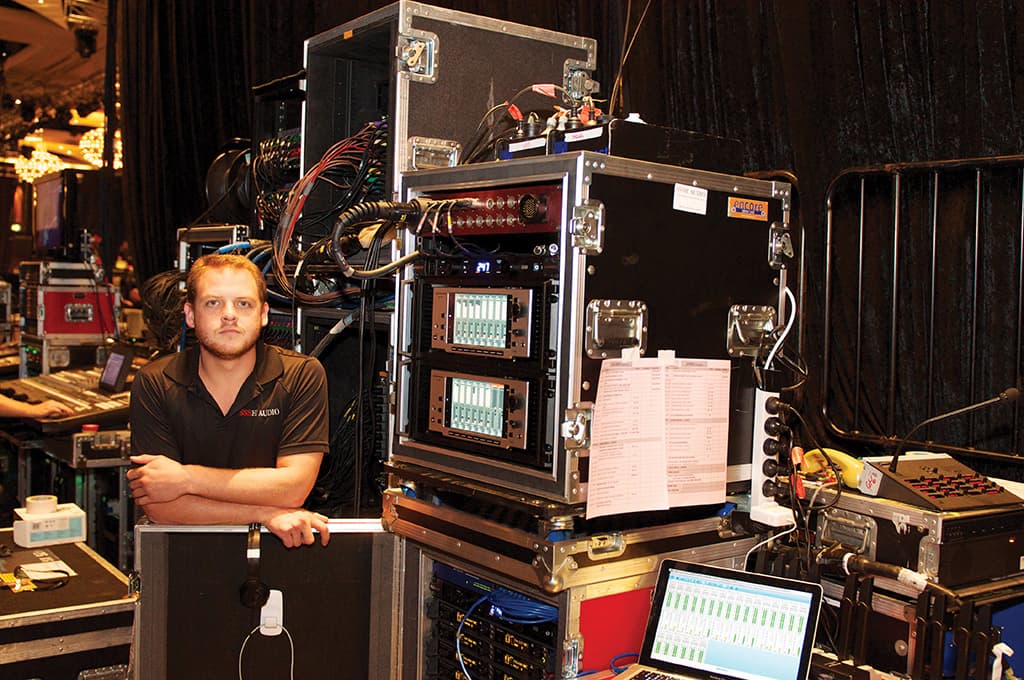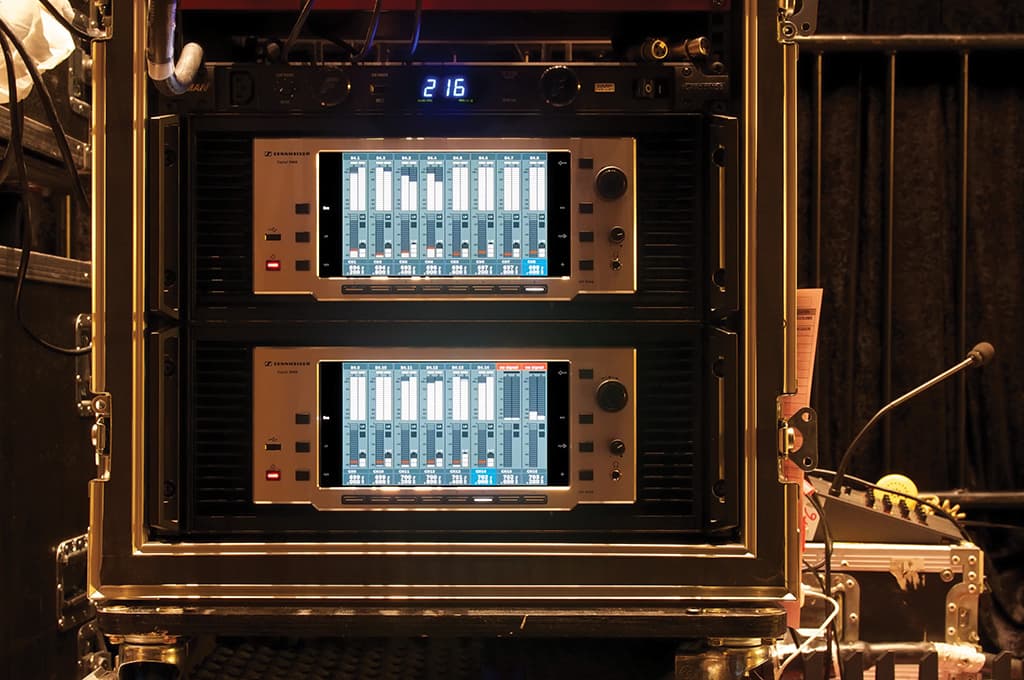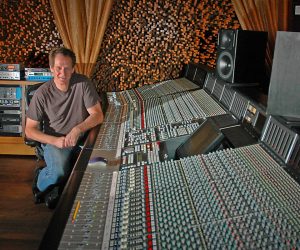
SSSH, It’s a New Sennheiser
SSSH Audio were the first to take delivery of Sennheiser’s new flagship wireless system, the digital 9000 series. And its first gig? The Logies.
SSSH Audio recently took delivery of Sennheiser’s flagship wireless system, the digital 9000 series, and they’d rather you kept it to yourself. While Sennheiser’s Australian distributors Syntec might have something to say about it, SSSH Audio would be perfectly happy if not another 9000 unit made it into the market. Why? It’s their competitive advantage. While Shure’s Axient product line has helped transform mega-event wireless systems, the first word on broadcasters lips is still German. And right now, the 9000 is the cream of Sennheiser’s wireless crop.
SSSH Audio is made up of Colin Swan and Brendan Drinan, two professionals that decided to start a company together dedicated to providing wireless audio with zero dropouts. So far, so good, they reckon — not a single bit of hiss, or any instantaneous interruption to report. Colin’s other main gig is traipsing around exotic locations with TV show Postcards, and when I first call him, he’s getting pulled by the lei towards a luau — lucky (Hawaiian) duck. Likewise, Brendan works on a lot of TV shows, in fact, the first show he used the 9000 system on was the TV Week Logies. If it had stuffed up, the entire broadcast industry would know. Talk about a baptism of fire.
In fact, the Logies was the first time Brendan had ever used the system on a gig. So if setting up was going to be an issue, he would have found out the hard way.
GET BEHIND THE EIGHT BALL
At the core of the 9000 system is the EM9046 receiver that’s tuneable from 470-798MHz, though the operating frequency range depends on which transmitter you purchase, with each of the four transmitter bands extending through a wide range of 88MHz.
The system is intended to be an eight-channel device (the screen layout, case size and connection panels are all geared to handle eight channels) but purchasers are able to tailor the number of DRX processing modules installed from one up to eight. That said, it’s not a plug-n-play operation — the distributor has to crack the unit open — and if you buy eight channels worth, it works out to roughly $11,000 per channel, so you can’t exactly dip your toes in.

THE FAT WILL FLY
The 9000 system has two modes of operation: Long Range (LR) and High Definition (HD). Long Range uses the Sennheiser Digital Audio Codec (SeDAC), while HD provides uncompressed audio. That’s right, no data compression, over wireless. Using Sennheiser’s HD mode, what comes out of the A/D conversion stage at the transmitter is exactly what gets transmitted to the receiver. Analogue wireless devices had to use compansion that limited dynamic range in order to transmit the signal. D9000 has none of this in either mode.
It means that, according to Brendan, the 9000 series passed the ‘keys test’ with flying colours. Most wireless mics struggle to transmit the sound of car keys being jangled in front of them. “The compansion is trying to handle those really short, sharp, high transients. It just can’t hack it,” explained Colin. “Another example is a cooking segment when the fat starts spitting in the pan, I’ve had radio microphones sound terrible. You can hear all the weird artefacts. Sennheiser has totally gotten rid of that in the HD mode, it’s about as good as a cable.”
“Mind you I have heard other sound guys tell me their plug-in transmitters sound better than a cable,” said Brendan. “I don’t know how they come up with that!”
Though there are limitations to using HD mode. “HD mode is 10mW transmit, which would work for onstage purposes,” said Brendan. “You lose range because the power is a lot lower. The Long Range mode runs at 25mW, which is fine for a room application.”
The night of The Logies Brendan ran the system in LR mode because the main event is held at The Palladium in Crown Casino in Melbourne, and performers could be anywhere in the 1500 capacity (banquet mode) venue. “The artist might walk all the way off stage to the other end of the room,” said Brendan. As for the range: “We were running the handhelds in LR mode from the stage and the FOH guy was chatting on them at the other end of the room to tune the system. He had his hand over the antenna as well and it wasn’t dropping out. We had it running in HD mode at the other end of the room as well, but we didn’t run with it on the night because it was a live night and our first time.”
It was also the lowest noise floor they had ever heard in a system. “We had 15 channels of handhelds onstage and we had clean silence,” said Colin. “Usually when you’ve got 15 handhelds onstage you’ve got all this noise floor as well. It was fantastic.”
If it had stuffed up, the entire broadcast industry would know, talk about a baptism of fire
IN IT TO SING IT
In a way, because most of the major networks want to use Sennheiser, the decision was already made for Brendan and Colin. But one of the key updates on the new system was to the handheld transmitters, and with talent shows like The Voice, Australian Idol, and much of Australia’s Got Talent relying on vocal performances, it puts them in the box seat for those jobs.
Brendan: “The things about the 5200 series handhelds operators didn’t like have been resolved in the 9000 series microphone. A big complaint was they suffered from handling noise, and it’s such a lightweight microphone. Both have been addressed in this mic.”
Colin: “Also, the newer series doesn’t pop as much. Broadcasters don’t like using windsocks because of the look. With these microphones you can put the windsock on in the inside of the capsule, not on the outside. The mics are squarer in shape so they’re less likely to roll around, and they feel better than the 5200 transmitters.”
Indeed, the 9000 transmitters do feel much nicer to hold than the 5200 versions — weightier, in a comfortable way. The system is different, it’s a screw-on system like the 2000 series, which immediately seems more robust. So far there are 12 different capsules available for the SKM9000 transmitter. There is a range of Neumann condenser and Sennheiser dynamic and condenser heads with different polar patterns and response characteristics. At the moment, SSSH Audio has Neumann and Sennheiser cardioid and supercardioid condenser heads, as well as a Sennheiser dynamic.
BIG GAINS
There are loads of features packed into the 9000 series, and a lot of them are designed to make life easier. Colin points out a handy one: “You don’t have to add gain into the antenna anymore, it automatically boosts it back up at the receiver. And if you run a faulty BNC-to-BNC-type RF cable, it’ll let you know if the cable is faulty and you can replace it instead of running around trying to figure out what’s wrong.”
“The more cable you have, the more gain you need to get it back to zero,” said Brendan. “With the other system you had to guess, ‘Will I add 5dB or 10dB?’ The trouble is the more gain you add to the cable, the more shit you drag in, so there’s a trade-off.”

THE LOGIES
At The Logies, Colin was doing the other RF component — the red carpet and The Today Show following the event. So he had 30-odd channels of 5000 series operating downstairs leaving Brendan upstairs with the 9000 series.
So how did he find it? “It’s really easy to set up,” said Brendan. “The great thing about it is because of the incredibly steep filters, you can run 40 channels in a 24MHz frequency range without intermodulation, whereas in the analogue system the maximum was about 16. You’re more than doubling your channels within a given bandwidth. If you’ve got eight mics, you can easily find space for them in 40 channels. If you need more space, you just set up another eight rack with another pair of antennas to grab 40 more channels.”
You can use Sennheiser’s Wireless System Manager (WSM), but Brendan found everything he needed to set up the system on the front panel LCD.
“It’s simple because if you just run the 9000 series, you don’t have to worry about intermodulation anymore — you don’t have to plot frequencies. You just run it 600kHz apart in an area that’s clean and you should be fine.”
















RESPONSES